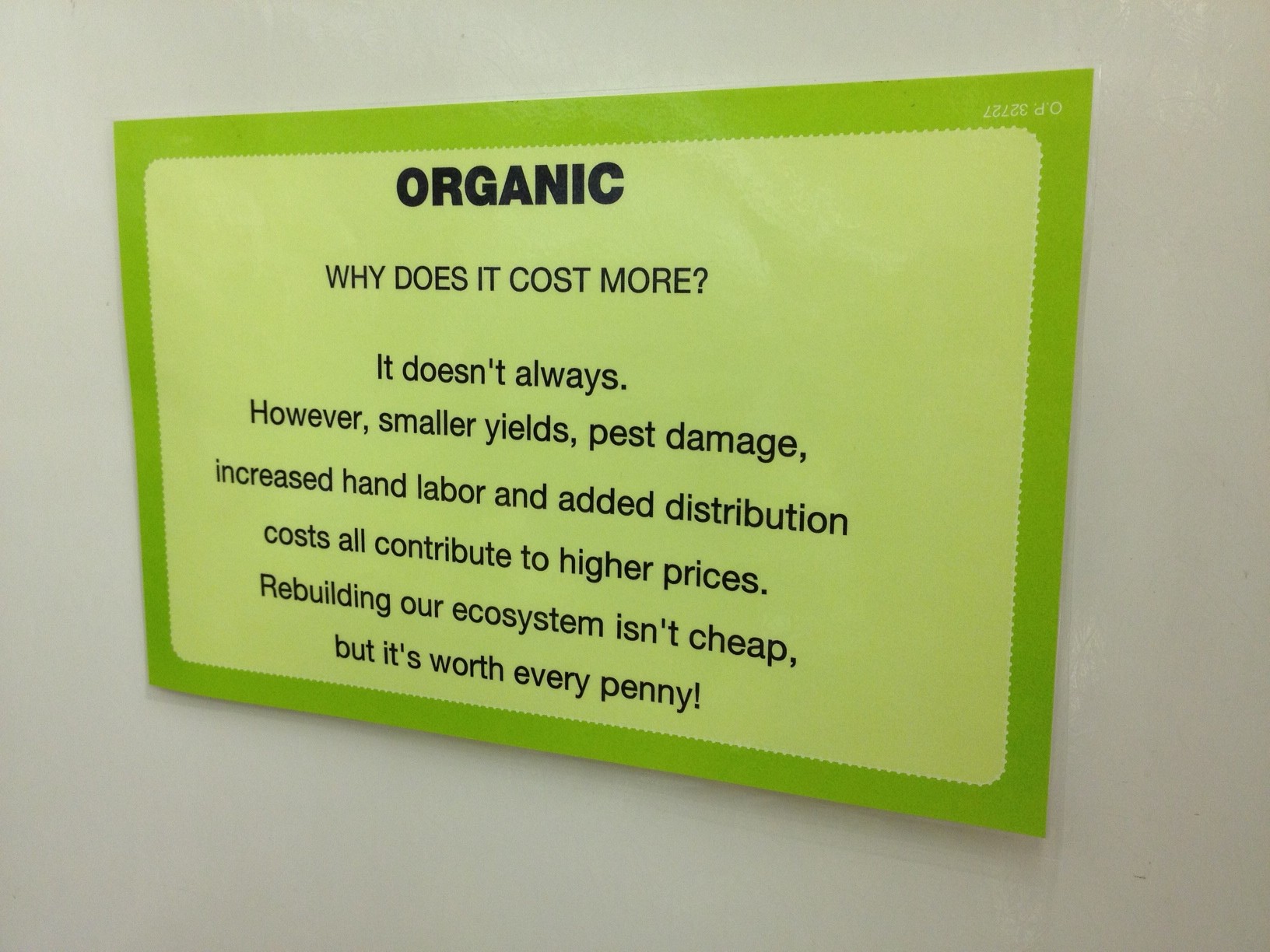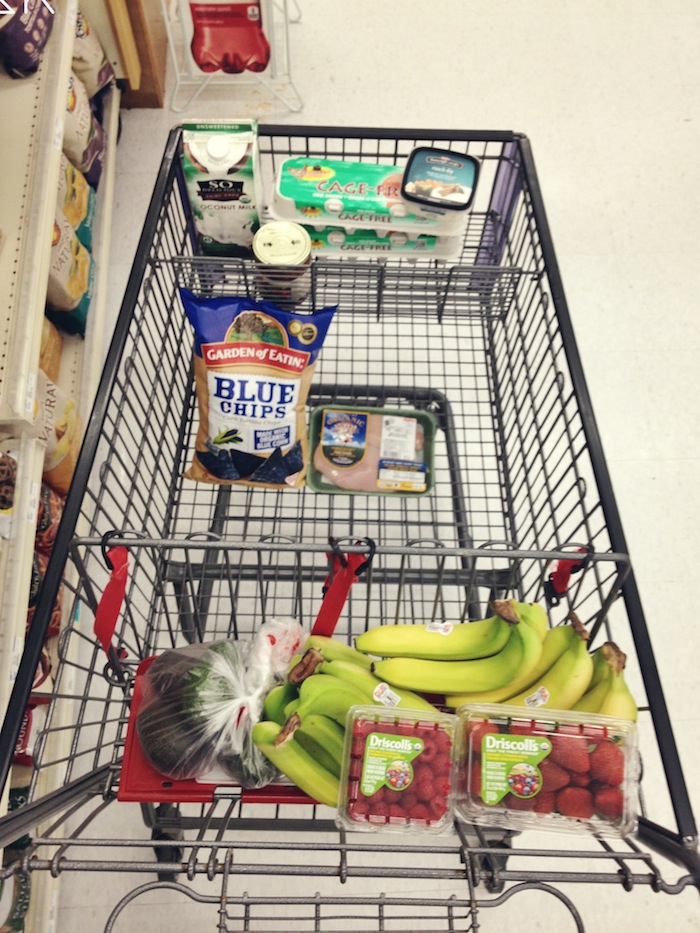A Grocery Trip // 03
In our most recent post about our journey to eating healthier, there were a few commenters wondering about the details of our diet, what we purchase at the grocery store, how much it costs, and what kind of meals we have been making lately. Today we'll review all of those items. Just remember that it's taken us 18 months to get from our first grocery post to this current one. It still makes me sick to look back. It took us quite awhile to get where we are, and if you are thinking about giving healthier eating a try, it just takes a bit of curiosity and willingness to try and learn about it. One step at a time!
Our Most Recent Grocery Trip
I remember when we first started to try and eat healthier that one phrase didn't quite make sense to me, nor did I believe that we would ever really do it: "Shop the perimeter of the grocery store," which means produce, meat, eggs and no processed food. Well, we pretty much do that today. The only aisles we go down are in the health market section, where most of the organic, healthier options live. (Isn't it kind of strange that grocery stores even need a health section?)
Here is a breakdown of what I picked up last Sunday evening at Hy-Vee. Sorry, this was a solo trip to the store, so no Rooney in carts photos.
- 12 cage-free eggs ($2.49 x 2): I have three eggs for breakfast every morning. Great source of protein and good fat.
- Garden of Eatin' Blue Chips ($4.59): Must-have for guacamole (see below).
- Salsa ($3.69): For my eggs in the morning. A good substitution from ketchup, which I used to put on my eggs.
- So Delicious Unsweetened Coconut Milk ($2.69): This was a first for us, and by us I mean Rooney. She's been drinking organic whole milk, but we're going to try this to cut out the dairy.
- Smart chicken breasts ($9.26): Two cage-free, antibiotic-free, organic chicken breasts.
- Avocados ($1.50 x 5): Rooney eats quite a bit of avocado. It's got the good fat she needs for her developing mind. Occasionally we'll have a bit of it as well, but Rooney usually eats about ½ an avocado per meal when we have them. (FYI, these are cheaper at Trader Joe's.)
- Bananas ($0.59/lb x 6.67 lbs): Yep, 6.67 pounds of bananas. That's 16 bananas and I don't think it will last us through the week. Bananas are Rooney's absolute favorite. She signs "more" and grins from ear to ear in a giddy laugh every morning when we ask her if she wants a banana. She also tries to say it ("Nanny!"). It's so cute!
- Organic strawberries ($3.59): Kelsey likes to take these for lunch. Rooney will have one every once and a while and I like to snack on them after work occasionally.
- Ranch veggie dip ($2.49): Kelsey has this with baby carrots for lunch sparingly. Our chiropractor told us that you could dip carrots in the worst possible ranch dip, and the benefit you would get from the carrots would far outweigh the dip. Score!
- Organic rasberries ($4.77): Kelsey takes these for lunch as well.
Total: If you are keeping track, this was a $48.20 trip to the grocery store.
What We Had at Home and Keep On Hand
- Frozen vegetables: Peas, green beans and corn for sure, but sometimes we get a mixed veggie bag as well. These are great because they are often frozen at their peak nutrition value and last longer than fresh veggies.
- Meat: We buy most of our meat in bulk from Wallace Farms. They run an amazing service with lots of options of grass-fed, organic meat. We keep ground beef and beef sticks on hand mostly, but have tried their sausage and bacon as well. This summer I hope to get some steaks and chicken breasts (they are usually out of them).
- Baby carrots: We both eat these at lunch time. Kelsey likes hers with ranch dip (not the healthiest choice, but the carrots far out weigh the negatives of the dip, and she is very sparingly dipper all around).
- Guacamole: We like Wholly Guacamole because it's pre-made and uses quality ingredients. Kelsey eats the 100 calorie packs for lunch, but we often find ourselves munching on it in the evening while making supper. Roo even loves it!
- Baby spinach: I use this for salads for lunch.
- Deli meat: Same here. I just rip it up and throw it on my salad. I'd love to find some grass-fed, organic options, but have had little luck in this department (the stuff at Whole Foods was really spendy). I get this from the deli counter.
- Nuts & berries: We buy from the bulk bins in our health department. I usually throw a mix of almonds, cashews, dried blueberries and dried cranberries in with my salad. Kelsey loves her organic flame raisins.
- Sunflower seed and almond butters: Kelsey eats celery and sunflower seed butter for breakfast, and I switch between the two as a snack here and there.
- Celery: Kelsey has this sliced up for the week and eats it for breakfast.
- Other fruits and veggies for juicing: We are new to juicing, but thus far we have kept kale, cucumbers, apples, oranges, beets, ginger and celery on hand.
Meals
This has been a bit tricky for us, but recently we came to a somewhat simple solution. We are not super adventurous in the kitchen and prefer meals that are quick to make and simple recipes. So, we are tying to stick to cooking a meat and vegetables when we make supper at home.
This might include: ground beef, steaks, chicken breast, pork chops or fish (we recently had some frozen wild caught flounder). This is why you see chicken breast in the shopping cart above. We then either cook some frozen veggies we have on hand, juice some vegetables or make a salad.
Sorry if you were hoping for more, this is just where we are right now. In addition to these meals we make at home, we still order food for takeout once or twice a week, and go out to eat occasionally. This leads to one or two nights of leftovers as well.
So you can see, we try to eat really healthy for breakfast 7 days a week, lunch 5 days a week, and dinner a few times a week. We have some room to grow on the weekends and when we eat out. And in those cases, we are making better choices than we have in the past, because we've made enough changes to realize that we really don't feel great when we eat terribly. (No more Dairy Queen or Taco Johns, lots more Chipotle.) Baby steps.
Budget

I will not sugar coat this. Eating healthy can be more expensive. Mostly due to the American food system and how cheap it is to make processed foods vs. grow organic, natural food. Real, raw, whole food is a shock to the budget when you first start trying to make changes.
We've increased our food budget in the recent months from $400/month to about $480/month. This was for two reasons.
- We took some of the money we were spending on Rooney's infant formula and added it to the food budget since she turned one and is now eating table food.
- We recognized that we needed more money if we were going to eat healthier, and juicing vegetables is pricey, too. But, as someone pointed out in our last post, we justify this by asking ourselves the following question: "Would you rather pay more for your food, or pay the doctor?"
You can semi-justify some of these increases by substituting. For instance, if you are buying potato chips every week at the store, why not buy some veggies for snacks instead? As you think of it in this way, some of these substitutions might save you a bit of money in one area, and might be a bit more in others.
What's your biggest challenge with eating healthy?

